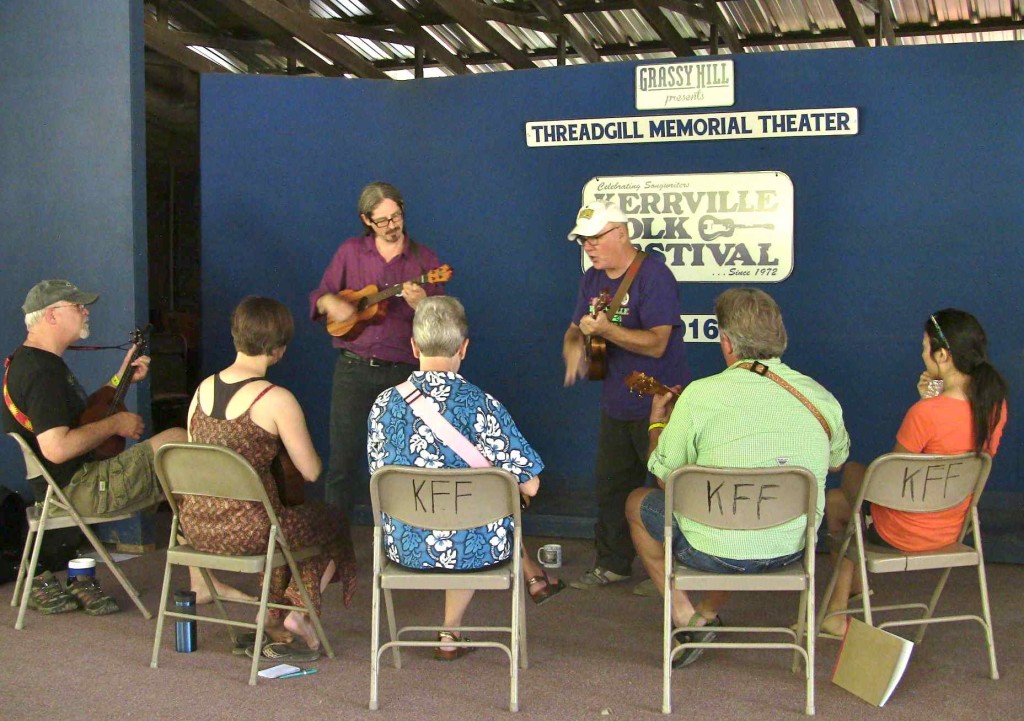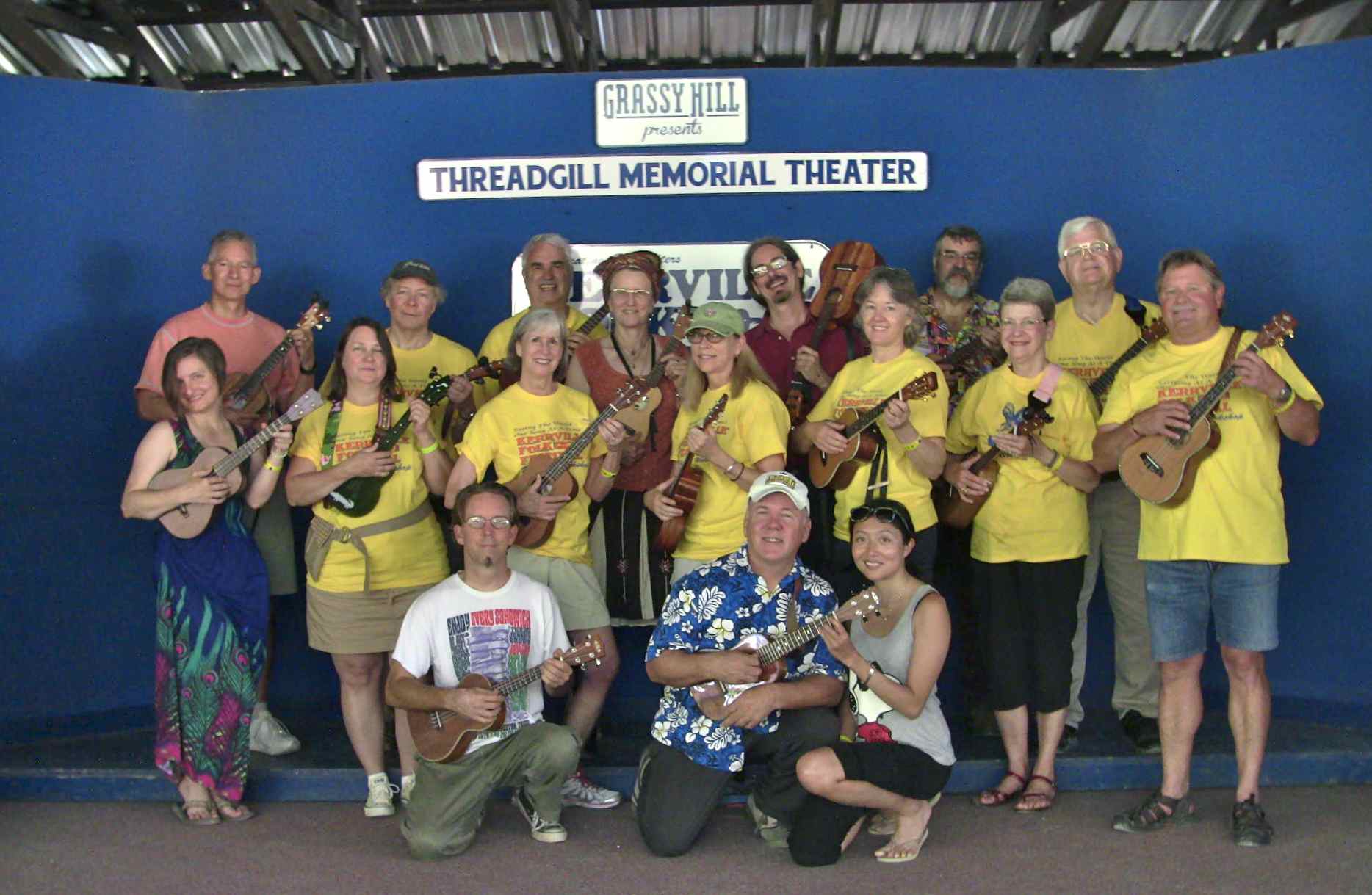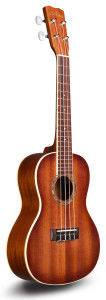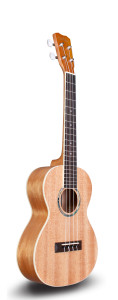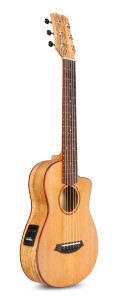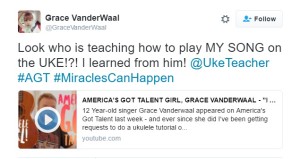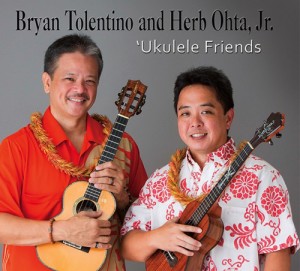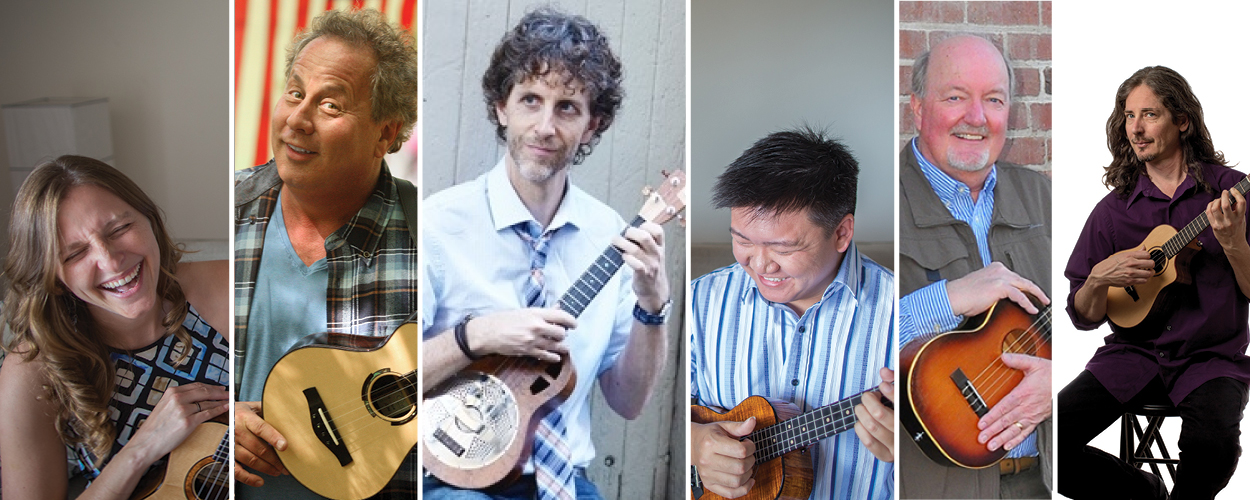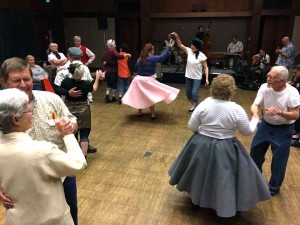Monday, June 20, 2016
Sunday, June 19, 2016
Wednesday, June 15, 2016
Deep In The Heart of Ukulele at the Kerrville Folk Festival
Text and photos by Jim D'Ville
You can't get much deeper into the heart of Texas than the Hill Country city of Kerrville, an hour drive northwest of San Antonio. If you had visited Kerrville in 1929, you may have seen the “Father of Country Music,” Jimmie Rodgers, playing downtown on the corner of Water Street and Fredericksburg Road (Rodgers moved there in 1929 for his health). But these days Kerrville's musical claim to fame is the Kerrville Folk Festival. For the last 45 years, the festival has been an annual 17-day-long homecoming for both novice and professional singer-songwriters. Notable musicians who got their big break through the Kerrville New Folk Contest include Steve Earle, Nanci Griffith, and Lyle Lovett.
But for the last four years, the Kerrville Folk Festival has accepted a new instrument into its folk-family fold: the ukulele. Dalis Allen, KFF Producer, explains her decision to add a three-day ukulele workshop camp into the Kerrville festival. “I knew that the ukulele had been gaining in popularity as it's a very accessible instrument. I stopped Del Rey, who has been a major force on the ukulele for years, in the hallway at Folk Alliance and asked what she thought of the idea. It was hatched then and it has been a great addition to the workshop offerings at Kerrville.”
This year's event was held May 26–June 12.
Rey, from Seattle, Washington, has been the Director of the Kerrville Ukulele Camp since its inception in 2013. She explains how the Kerrville uke camp schedule differs from other camps and retreats. “I try to incorporate enough time in the schedule so people can absorb what they've just heard and are learning to play. Learning a tune is like watering the lawn, you don't want the water just running down the sidewalk! I also like having a couple all-camp classes, where three instructors teach as a team. That way, the lead instructor has back-up, and the students have individual attention without feeling like they are interrupting the flow of the class.”
Past instructors at the Kerrville Folk Festival ukulele camp have included James Hill, Victoria Vox, and Aaron Keim. This year's trio of instructors consisted of Del, string wizard Daniel Ward from Los Angeles, and myself.
The Kerrville Folk Festival Ukulele Camp is normally held the first week in June and runs for three days, 10 am to 3 pm. All classes at the camp are held at the Threadgill Theater, a covered, open-air venue on the festival grounds. Lunch is provided each day of classes as is an evening folk concert that takes place each night at the Threadgill from 7 pm to 9 pm.
Meg Hoke, a three-year veteran of the uke camp from Asheville, North Carolina, says, “It's such a laid-back atmosphere at the Kerrville Ukulele Camp. From the first minute of the camp, there is no intimidation. It's a very supportive environment, both from the instructors and the other students. I've really been able to build upon my skills every year.”
The Kerrville Folk Festival is part Woodstock, family reunion and three-week jam session all rolled into one. The dedicated festival grounds are the Quiet Valley Ranch, located eight miles southwest of Kerrville. The image line for the festival is “Welcome Home,” since many of the participants have been coming to the festival for decades it really is a musical homecoming. Most tend to congregate in well-established tent camps with friends while others go the trailer or RV route. For the less adventurous, the comfortable Y-O Ranch Hotel in Kerrville is also an option (that's where the instructors stay).
One of the highlights of visiting the Texas Hill Country is the food. This year's trip to Kerrville included multiple breakfast trips to the Hill Country Cafe, a Texas legend since 1942; Bill's Bar-BBQ, also in Kerrville, proved to be the real deal in Texas BBQ; and for the more sophisticated palates, Grape on Main Street in Kerrville was a lovely dining option.
Since the ukulele camp workshops finish up at 3 o'clock every day, it leaves ample time to explore the surrounding countryside. An annual activity for the instructors is a refreshing swim in the Guadalupe River, which runs through downtown Kerrville. With temperatures normally in the high 80s with some humidity, an afternoon dip in the Guadalupe is a welcome respite.
With the average yearly attendance around 30 students, the excellent student-to-teacher ratio makes for a lot of one-on-one interaction and individualized instruction. And if you're into the singer-songwriter aspect of the ukulele, this event is a must for you.
For more information on the Kerrville Folk Festival and the KFF Ukulele Camp, visit www.kerrvillefolkfestival.org.
New Ukes from Cordoba
By Greg Olwell
Cordoba is introducing two new ukuleles--at next week's Summer NAMM show in Nashville, Tennessee.
Two new ukuleles expand on the format and design of the company's top-seller, the all-mahogany Cordoba 15CM. First up is the 15CM-E concert, which has an undersaddle pickup and a matte 'burst finish. And, for players who may want the popular concert-sized model, but with the room and voice of a tenor, the 15TM features similar appointments, scaled up to tenor size.
Though not technically a ukulele, the company's new Mini SM-CE might appeal to players looking for a small instrument with an extended range. Billed as a travel-sized guitar, the six-string Mini SM-CE features a spalted maple body with a solid cedar top, a cutaway, and a pickup. It has a 20-inch scale and uses custom Aquila strings for an A-to-A tuning. (An E-tuning set is also available.)
SPECS
15CM-E Concert with pickup
- Mahogany top, back, and sides, abalone-style rosette, cream body and fingerboard binding
- Mahogany neck with rosewood fingerboard, 35mm nut width, 375mm scale length
- Matte edge-burst finish
- Cordoba undersaddle pickup
- Aquila Nylgut 7U strings
$129.99 (street)
15TM Tenor
- Mahogany top, back, and sides, abalone-style rosette, cream body and fingerboard binding
- Mahogany neck with rosewood fingerboard, 35mm nut width, 432mm scale length
- Matte finishAquila Nylgut 10U strings
- $99.99 (street)
Mini SM-CE
- Solid cedar top, spalted maple back, and sides, padauk binding
- Mahogany neck with rosewood fingerboard, 50mm nut width, 510mm scale length
- Matte finish
- Cordoba 2Band pickup
- Aquila Mini strings
- Cordoba gig bag
- $329.99 (street)
For more information, visit Cordoba's website.
Tuesday, June 14, 2016
Monday, June 13, 2016
America's Got Talent's 'Uke Girl' Receives Pleasant Surprise Lesson-From Her Teacher
By Greg Olwell
Showing the speed of the contemporary culture, online ukulele video instructor John Atkins has already posted a lesson of last week's viral video by 12-year-old Grace VanderWaal on America's Got Talent.
Under his YouTube channel, The Ukulele Teacher, Atkins created a lesson of “I Don't Know My Name,” a stunner of a song written by VanderWaal and performed on an episode that aired June 7.
Well, Atkins' lesson received a big boost on Sunday, when VanderWaal posted the following tweet on her Twitter account, showing surprise that she learned to play from watching his videos and now he was teaching her song.
Wednesday, June 8, 2016
12-Year-Old Wows America's Got Talent, Called “The Next Taylor Swift”
By Greg Olwell
Accompanying herself on a ukulele, 12-year-old Grace VanderWaal wowed the judges and the audience on last night's America's Got Talent. Seconds into her song, “I Don't Know My Name,” the Suffern, New York student was getting cheers of approval from the crowd and shortly after finishing, the judges gave her a special acknowledgement that advanced her in the show.
Judge Howie Mandel rang the show's golden buzzer, a concept that each judge is allowed to use only once a season. When a judge rings this buzzer, the contestant automatically advances to the show's quarterfinals, bypassing the other judges' votes.
While still holding her Luna Uke Tattoo Concert onstage as her family swarmed, judge Simon Cowell smiled and said, “I think you are the next Taylor Swift.”
Check her out on Twitter, @GraceVanderWaal
Tuesday, June 7, 2016
Monday, June 6, 2016
Thursday, June 2, 2016
The Tiny Ukulele Makes Major Inroads In Berlin
From the Summer 2016 Issue of Ukulele Magazine | BY ELIZABETH RUSHE
In cozy bars and venues dotted around Berlin, Germany, ukulele meet-ups attract lively crowds, from multi-instrumentalists to novices, as well as those who simply want to sit back and enjoy an evening of uke tunes. Much of Berlin's active ukulele scene can be traced back to Leleland, a welcoming ukulele shop in Kreuzberg, which claims to be the largest of its kind in Europe.
Harald Truetsch, who plays ukulele in a rock band named Toxic Tones, opened Leleland seven years ago and organized some of the first ukulele gatherings in Berlin. Truetsch reflects that most of his customers are from abroad. As he says this, a pair of giddy German teenagers tumble in to purchase their first ukulele. Truetsch plucks the instrument expertly to tune it before handing it over. With a beckoning wall of ukuleles and Truetsch on hand to offer advice, the shop is stocked with rarities, such as the limited-edition Ibenez with a Steve Wei fretboard inlay; a custom-made ukulele by Australian guitar luthier Cole Clark; and German-made ukuleles. Leleland does get a lot of international customers, however-people hear about the shop and put it on their must-see itinerary when visiting Berlin. Truetsch is particularly proud of a recent visit by Tomoki Sato-the internationally renowned Japanese ukulele player, vocalist, and composer.
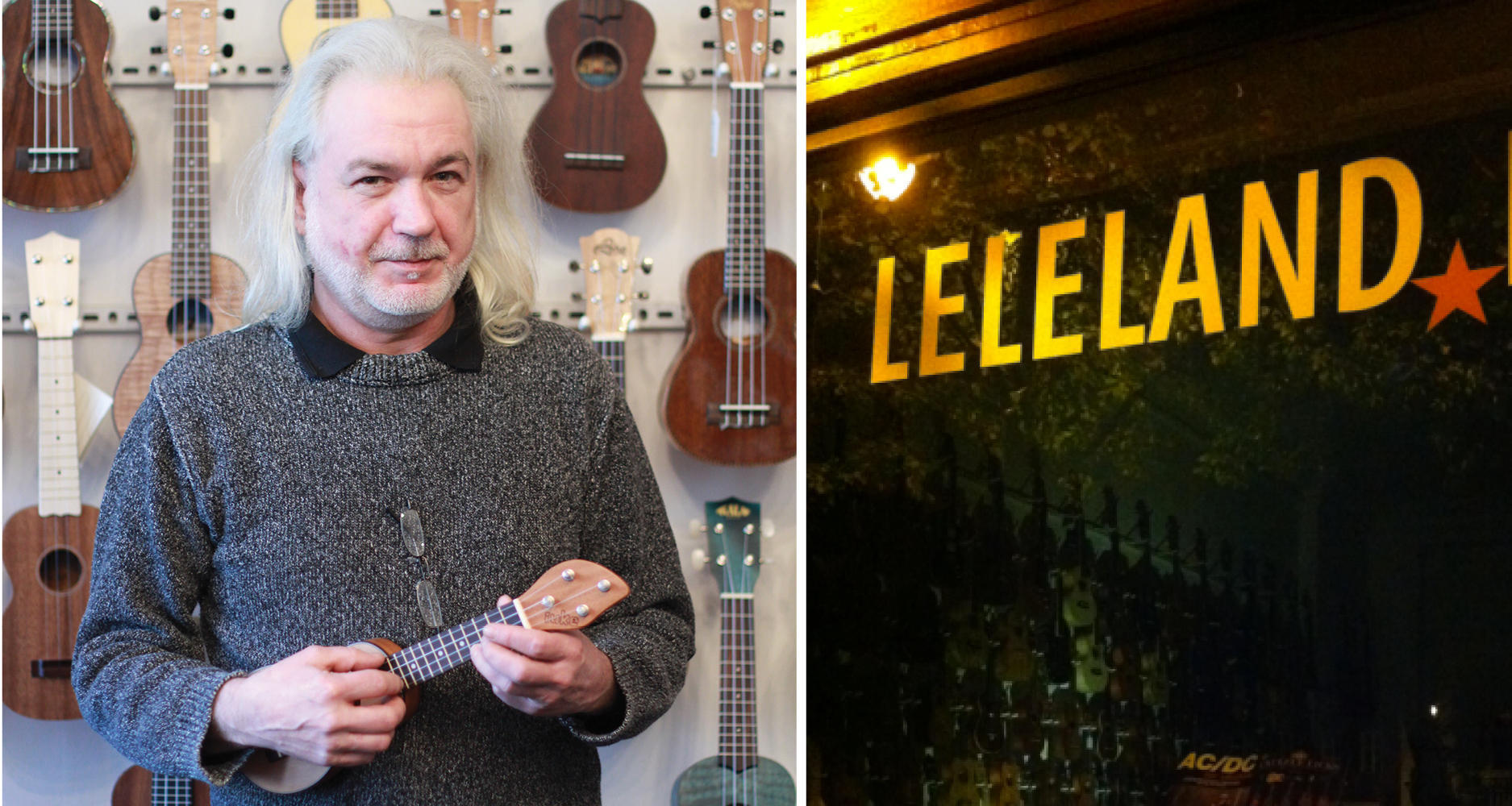
Harald Truetsch and Leleland
The shop was the initial meeting place for the longest-running uke meet-up in Berlin: the Ukulele Stammtisch (stammtisch means regulars' table). It started seven years ago and now meets twice a month-every second Thursday and every last Tuesday in Lagari, a cozy bar in the neighborhood of Neukölln. Organizer Matthias Müller-Guth says the Stammtisch is open to everyone, from beginners to advanced players-the vibe is friendly and welcoming, there's a willingness to share technique and skills with those who are learning. This group is especially ideal if you want to improve your German, since all members are local (though happy to chat in their excellent English, too), that is to say, they're “actual” Berliners, which believe it or not can be quite rare in this city. Order a locally brewed beer from the bar, and you're all set. Many who regularly attend the Stammtisch group are active in their own ukulele bands and orchestras, such as the Gentle Ukes (the-gentle-ukes.de), Berlin's all-ukulele orchestra. The orchestra practices on Fridays, and interested uke players can participate in a few practices before they sign up to be a member of the orchestra, which celebrates it's sixth anniversary this year.
Uke Boogie is another regular ukulele meet-up in Berlin: a lively night of open-mic spontaneity that takes place once a month, organized by Alex Highet, originally from Scotland. Highet brought the Uke Boogie night with him when he moved to Berlin-the Boogie will have been running for three years in May of this year. Each month, in addition to the glory of performing in front of a delighted audience, the Boogie crew raffles a ukulele to a lucky member of the crowd. Instrumental diversity is encouraged, along with ukuleles.
“We try to encourage more unusual instruments, so we ask that guitar players leave their guitar at home,” Highet notes on the club's Facebook page.
Most people who get up to play perform on ukulele, but you might also be treated to a Kanye West cover on mandolin, or a cover of the Magnetic Fields' “Love is Like a Bottle of Gin,” accompanied on the box drum.
All styles of ukulele performances are welcome. A typical night includes German punk, French chanson, '90s indie-rock, and hip-hop. A highlight one evening was Highet's performance of an original song he'd written especially for Jonathan Richman, which led to a discussion on how to get a video of the song to the quirky American singer-songwriter, who apparently only communicates by snail mail. Uke Boogie attracts an equally friendly, slightly more international mix of people, including both players and audience.
And, of course, the prize-a ukulele-is a great reason to start learning to play.
WHERE TO UKE IN BERLN
Leleland Ukulele Shop
Ukulele shop in Kreuzberg
Uke Boogie
Open mic for ukuleles and other instruments that aren't guitars, every second Wednesday of the month. Uke Boogie is in between venues at the moment, check their Facebook page for new venue confirmation.
Berlin Ukulele Stammtisch
Every second Thursday and last Tuesday of the month.
Cogg Guitars & Ukuleles
Looking for a custom souvenir to bring home? Visit luthier Gary Neath at Cogg Guitars.
Nalu Diner
A taste of America, with a Hawaiian influence. All-day breakfast includes buttermilk pancakes, hash browns, eggs benedict, and bottomless coffee (a novelty in Berlin!). Co-owner James Kroll grew up in Hawaii, reflected in the name “Nalu,” meaning surf, as in a wave that's breaking.
The Konzerthaus
A beautiful, historic music venue, which hosts about 550 events a year. If you're in Berlin on May 8, don't miss the Ukulele Orchestra of Great Britain.
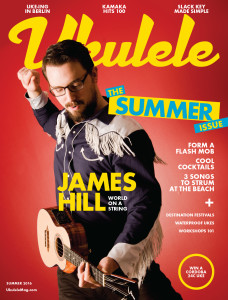
This article originally appeared in the Summer 2016 issue of Ukulele magazine.
Tuesday, May 31, 2016
Ohta and Tolentino Take Home Ukulele Album of the Year Award
By Greg Olwell
Ukulele players Bryan Tolentino and Herb Ohta Jr. won big at this weekend's Na Hoku Hanohano awards in Honolulu, taking home the Ukulele Album of the Year award. The awards celebrate Hawaiian music and given by Hawaiian Academy of Recording Arts.
Ohta and Tolentino won the award for their recent album, Ukulele Friends, a recording of a dozen duets by the long-time friends.
Japanese ukulele player Ryo Natoyama received the International Album Special Recognition award for his album Ukulele Splash, an award given to a non-US artist for their contributions to Hawaiian music.
The nominees for the Ukulele Album of the Year included
Da Ukulele Boyz, Jus Cuz, Ukulele Duets
Bryan Tolentino & Herb Ohta Jr, Ukulele Friends
Sunday, May 29, 2016
Friday, May 27, 2016
Workshops 101: Get the Most out of a Ukulele Workshop
From the Summer 2016 Issue of Ukulele Magazine | BY HEIDI SWEDBERG
Workshops at festivals and retreats offer ukulele enthusiasts great opportunities: exposure to new styles and techniques, an intimate shared experience with like-minded people, inspiration, and challenge. But with great teachers from around the world teaching compelling classes at the same time, the question becomes, “How to choose?”
First, know yourself. Start by assessing your skills. Think about what level of player you might be (Not sure? See below to assess your level). Classes geared to beginners will focus on accommodating the novice and make sure no one gets left behind, whereas classes for advanced players strive to keep the most skilled players challenged. Intermediate classes teach to the middle of the class and try to keep the less skilled in the loop without loosing the interest of the more advanced. Then, take a look at the summer workshops available and consider what kind of an experience you want to have.
A list of classes is a lot like a restaurant menu. Try to order a balanced meal, choosing your main course and some side dishes. Do you want to conquer a new style? Choose a class focused on a specific technique as your main course, and make the rest of your selections from there. A class teaching a song in your favorite style would be a good second course. Look for a third to compliment your pairing-perhaps a class focused on left-hand technique or relieving stress? For dessert, try hula or yoga, or go healthy and take your vitamins (aka theory)!
If learning a bunch of new songs is what you want, take every repertoire class offered, regardless of the skill level. Want to learn how to teach? Sign up for beginner classes and observe how different teachers approach new players. Love the way one particular staff member plays? Take all their classes regardless of level or focus and sit where you can really get a view of their hands.
The most common complaint voiced at festivals is “too-much too-quickly.” Although it can be hard to pass up on all the tasty choices, sometimes a richer experience can be garnered when you take fewer classes and give yourself time to absorb. If you learn something of particular interest, squirrel yourself away and take the time to practice before you forget the lesson.
Remember that a workshop is designed to introduce you to something new-a song, a technique, a skill. Mastery takes time, and the 60 to 90 minutes you share with the instructor and 10-100 other participants will not immediately change your playing. However, it will ignite your passion and give you something to work on at home. Commonly instructors will offer handouts, either in class or online. Many instructors will allow you to record the lesson, or will reserve a time at the end of a workshop for videos. Ask permission to post to the internet!
WHAT'S YOUR LEVEL?
Level 1: Beginner
Welcome! You are in this most exciting phase of the learning curve until you can move between chord changes and keep a beat. Get fluent with (at least) your C, F, and G7 and then head to the next level.
LEVEL 2: Early Intermediate
Now you're a player, but chord diagrams over the words are still a must. Your job here is to master B-flat, get some strums under your belt and grow into your instrument-this is when you truly learn how to practice.
LEVEL 3: Experienced Intermediate
Look at you, singing and strumming at the same time! You know a bunch of chords and are ready to use them. Time to dig in and learn some exciting techniques, and maybe venture further up the neck. Be proud of yourself, this is a fine plateau to reach.
LEVEL 4: Advanced
You can hear changes, you know some barre and closed chords, and have toured the real estate above the fifth fret. You are unafraid of the tricky stuff, ready to sit with the big kids. When things go over your head, watch and listen closely, then take your new ideas home to practice.
COMMON TYPES OF WORKSHOPS
TECHNIQUE focuses on left- or right-hand skills
REPERTOIRE workshops teach you new songs or fresh arrangements
THEORY is to music as grammar is to language
STYLES like flamenco, clawhammer, or chord melody increase your versatility
MUSICIANSHIP is what makes you sound better or grow as a musician
WORKSHOP ETTIQUITE
TUNE FIRST Be as close as you can to A440 before the workshop starts.
QUESTIONS LATER Too many questions can derail an instructor and bog down a class.
NO NOODLING! One of the hardest things about playing the ukulele is not playing the ukulele! Refrain from plucking and strumming while your teacher is giving instruction.
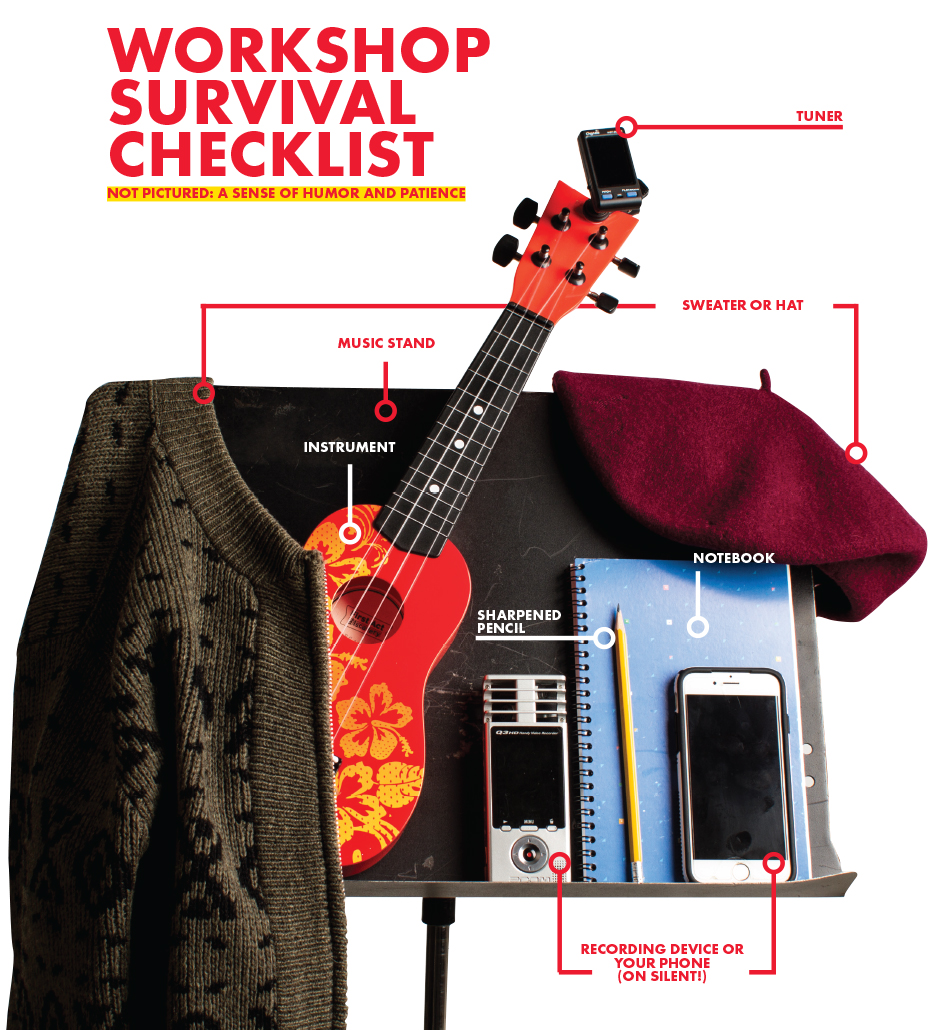
WORDS OF WISDOM
“Always go into a workshop with an open mind. No matter your skill level, there is always something to learn. There have been times that, even as a teacher, I have learned cool tricks from beginners.”
-Sarah Maisel, instructor
“You should not feel discouraged if you don't master all the material by the end of the workshop. The goal is to understand the concept, understand the technique, and master it at home.”
-Gerald Ross, instructor and festival organizer
“I want students to be as relaxed as possible, yet focused. Being relaxed allows more information to filter into their brains.”
-Kevin Carroll, instructor
“By giving out the worksheet after class (or following up the workshop with a quick YouTube video going over the big elements of the workshop), I can keep people focused on the task at hand.”
-Craig Chee, instructor
“If you aren't fairly accomplished with both hands in several different styles of music and you still want to attend [an advanced level class], please sit in the rear and do not ask questions.”
-Douglas Reynolds, founder of the Reno and Palm Strings Ukulele Festivals
“I like to give time at the end of class for video. Many things musical can only be felt and seen by watching someone break it down and play the material slowly.”
-Daniel Ward, instructor
Monday, May 23, 2016
Sunday, May 22, 2016
Thursday, May 19, 2016
A Look at the West Coast Ukulele Retreat
by Jim D'Ville
The West Coast Ukulele Retreat is a four-day sea-level ukulele immersion. It's a strumming and singing extravaganza with nearly 100 old friends, or soon to be new friends. Held in early May in Pacific Grove, California on the Monterey Peninsula, this premiere ukulele event just concluded its fifth successful year.
Organizer Elaine de Man has created the perfect ukulele getaway for those wishing to expand their uke skills in a number of unique musical settings. There are workshops designed for all levels of players taught by some of the top ukulele instructors in the world. This year we welcomed from England the wonderful Phil Doleman to the WCUR staff. Phil shared his love of blues, jug band, and hokum with us, as well as his zany sense of humor. Also on the staff was ukulele chanteuse Victoria Vox, who not only shared her beautiful voice but also graced us with many stirring mouth trumpet solos (she even taught a mouth trumpet workshop). It's always a treat when multi-instrumentalist Gerald Ross is on the WCUR staff. Not only is Gerald one of the top swing-ukulele players around, he's also a crackerjack guitar and lap-steel player.
Kevin Carroll from Austin, Texas, taught a number of “ukestra” workshops where groups of players from all levels learned to play some nifty arrangements of classic soul and zydeco songs. New to the WCUR workshop itinerary this year was an actual recording-studio experience taught by Dave Egan. In his day job, Dave is the sound engineer for Greg Rolie of Journey and Santana fame so you can imagine the thrill many students experienced getting to record a song and have it mixed down on the spot by someone of Dave's talents. The amazing duo of Daniel Ward and Heidi Swedberg were back on the WCUR staff this year. These two bring so much energy and talent to the event it's hard to imagine it taking place without them. Daniel wowed the students (and other instructors) with his virtuoso skill on the ukulele while Heidi once again organized our dining hall flash mob which is now a legendary event at Asilomar. After three days of practice the whole of the camp stunned about 200 other non-ukulele playing diners with a rousing version of “Sweet Caroline” that brought all eating to a complete stop!
Unique to the WCUR is the number of varied group activities. This year that included a 1950s costume dance night with a full backing band. The Flea By Night concert afforded the students the opportunity to play a song backed by the instructor band. The stunning finale to the West Coast Ukulele Retreat is the Saturday night battle of the bands. Each instructor is paired with a group of 7–10 students the first day of camp with the goal of creating a full-fledged band that performs their rehearsed and polished song in the final show. It's unbelievable the amount of talent and creativity that shines through in each performance.
All of this wacky ukulele madness takes place at the historic Asilomar Conference Center, a 107-acre spot of paradise located on the shimmering Pacific Ocean just south of Monterey Bay. The rustic buildings at Asilomar, a former YWCA leadership camp built in 1913, were designed by renowned architect Julia Morgan, the architect of Hearst Castle. The cottage I stayed in was purchased in 1932 by John Steinbeck's sister. In 1941 Steinbeck lived in the cottage while he wrote The Log from the Sea of Cortez. Four days at Asilomar and the stresses of everyday life melt away. And, by the way, there are no televisions.
I'm sure Elaine will assemble another wonderful staff of instructors for the 2017 West Coast Ukulele Retreat so if you're looking for a one-of-a-kind ukulele experience mark your calendar for next year now!
Photos courtesy of West Coast Ukulele Retreat.
Tuesday, May 17, 2016
Loosening the Keys – An introduction to slack-key-style ukulele
By Fred Sokolow
In 1832, Hawaiian King Kamehameha III hired Spanish and Mexican cowboys to teach Hawaiians how to deal with cattle. These vaqueros brought guitars to Hawaii and the natives developed their own fingerpicking style that incorporated Hawaiian rhythms and harmonies and magically evoked the natural beauty of the islands.
The music that the locals played became known as ki ho'alu (translating loosely as “loosen the key”), after the slack key, or lowered open tunings, they preferred. Since slack-key guitar involves an alternating thumb-bass picking style, many musicologists think it influenced African-American blues guitarists. Others say that some Hawaiians put open-tuned guitars on their laps and used a slide, giving birth to the steel guitar!
Though slack-key playing flourished, both as an accompaniment to singing and as an instrumental form, it remained island-bound until the late 1940s, when Gabby Pahinui began recording it. By the 1960s and '70s, slack key's popularity had spread and it got a big boost in the '80s when the label Dancing Cat Records released recordings by many masters of the genre.
At this point, you may be thinking, “That's all very interesting, but what does it have to do with my ukulele?” Well, it's only natural to try to transfer such a uniquely Hawaiian style of music to the instrument most associated with the islands. So, when I started writing an instructional book on slide ukulele, it hit me: Once folks have their uke in an open tuning for slide playing, why not try some slack-key playing as well? Slide Ukulele became Slide & Slack Key Ukulele.
This lesson is centered on one of the arrangements from that book, a 138-year-old Hawaiian standard called “Manu Kapalulu.” It will introduce you to the sound of slack key as well as one of the open tunings, some new chord shapes, and picking patterns.
“What,” you ask, “retune my uke? I'll have to learn to play all over again!” Don't panic-you'll only retune one string. The first string (A) goes down a major second (the equivalent of two frets) to G, giving you an open C chord: G C E G. This is the ukulele version of the Taro Patch tuning, the most popular of the many open tunings used by slack-key guitarists. (On guitar, it's D G D G B D, low to high, like the Delta blues guitarists' open-G tuning.)
In this tuning, you can use all your familiar chord shapes, but you'll obviously need to adjust the first-string fingerings.
Ex. 1 shows you how to do so with the handful of shapes that you'll use in “Manu Kapalulu.”
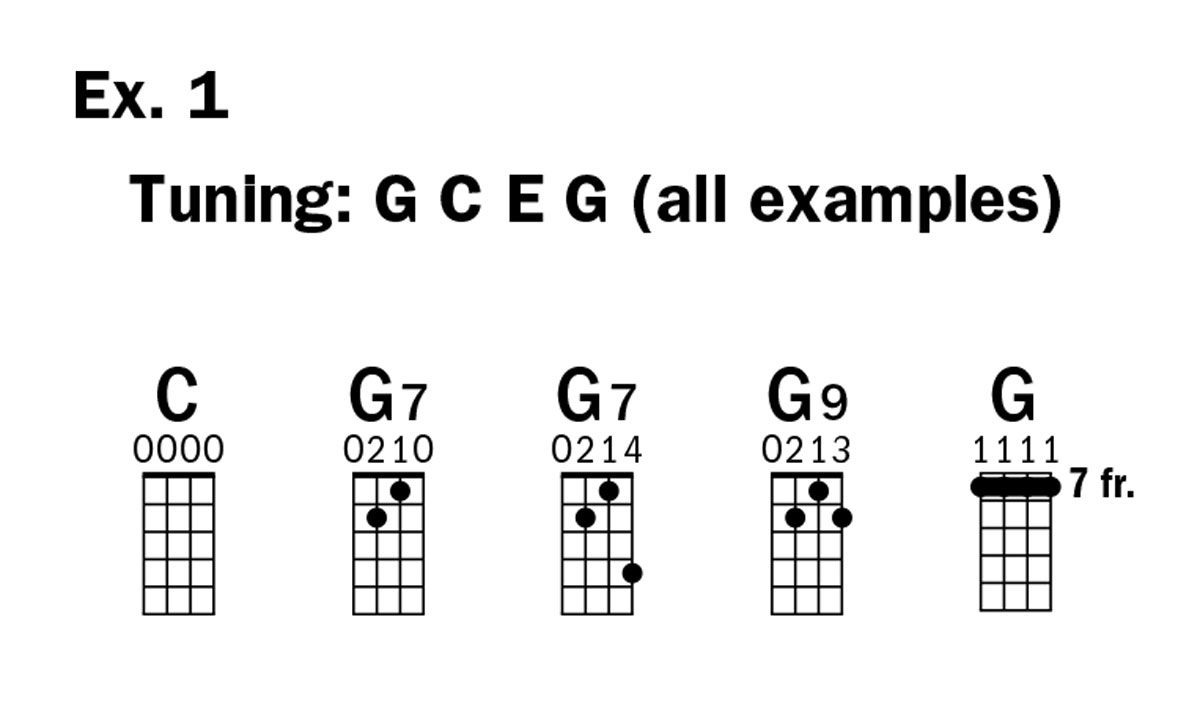
Slack-key guitarists tend to fingerpick a steady, rolling rhythm that creates an almost hypnotic effect. It usually involves the alternating bass picking associated with guitarists like the country pioneer Merle Travis and blues players like Mississippi John Hurt and Blind Blake. On a uke in reentrant tuning (having a high fourth string), there's not much bass, so the fingerpicking patterns keep changing, but the result is the same: the song's melody is augmented by the “extra” notes that surround the melody and keep the rhythm going.
Practice the rolls over and over, until they flow smoothly.
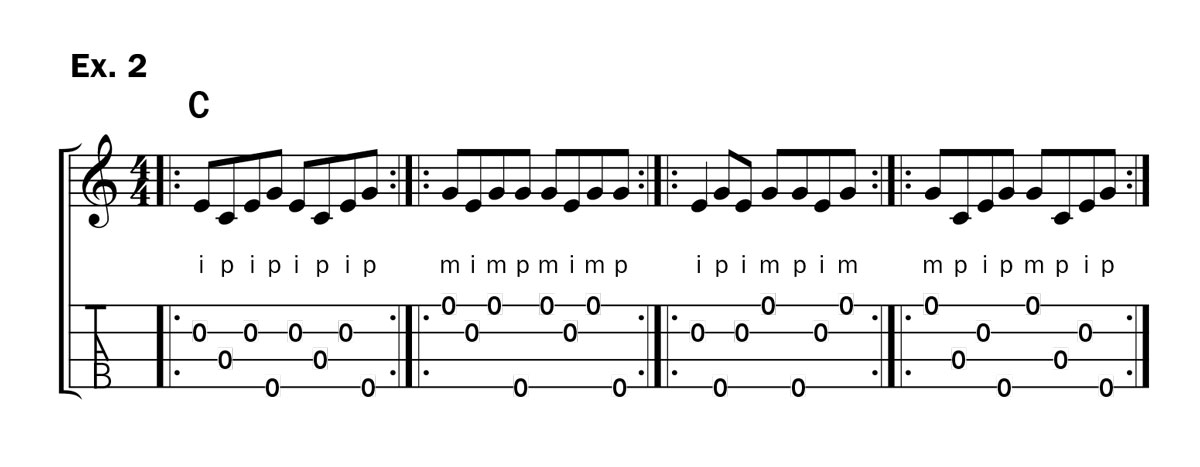
Queen Lil'uokalani, the last Hawaiian monarch, wrote “Manu Kapalulu” in the late 1800s. A prolific songwriter and promoter of Hawaiian music, she also penned “Aloha Oe” and many other tunes that are still sung, danced to, and played by slack-key artists and other performers, wherever Hawaiian music is heard.
“Manu Kapalulu” is literally about a quail, but it's really about someone with whom the queen was annoyed! The chorus translates as “Be quiet, you quail who nags me. You are nothing, in my opinion.”
You'll find the tune's basic melody in Ex. 3 and a full slack-key arrangement, in which the melody is enveloped by rolls, in Ex. 4.
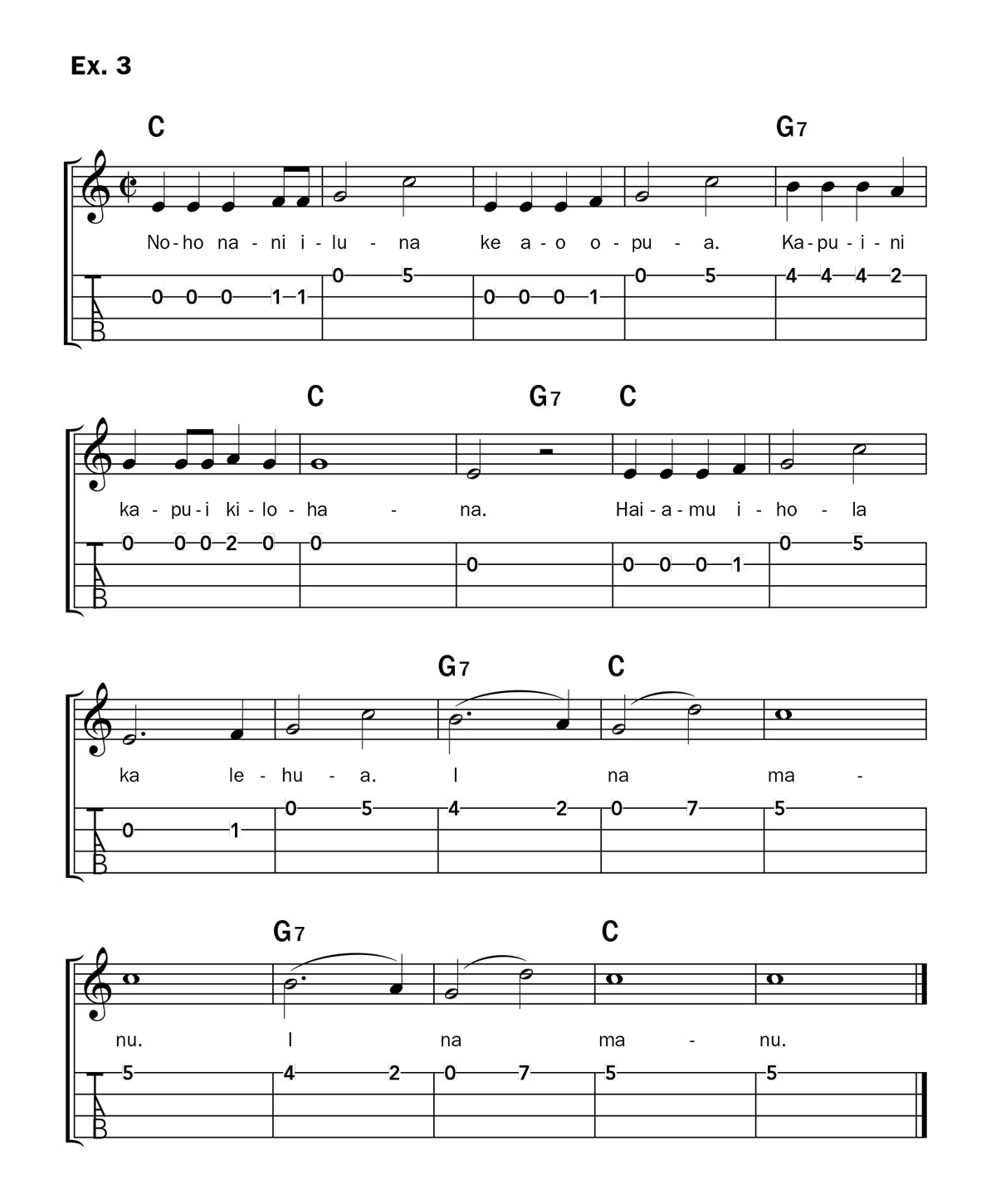
Before attempting Ex. 4, here are a few tips: 1) to play chords (as in measures 2 and 4), brush up with your middle or index finger; 2) the first two rolls in Ex. 2, with variations, make up a good part of the tune; and 3) the repetition of the last four bars is a characteristic of many slack-key tunes.
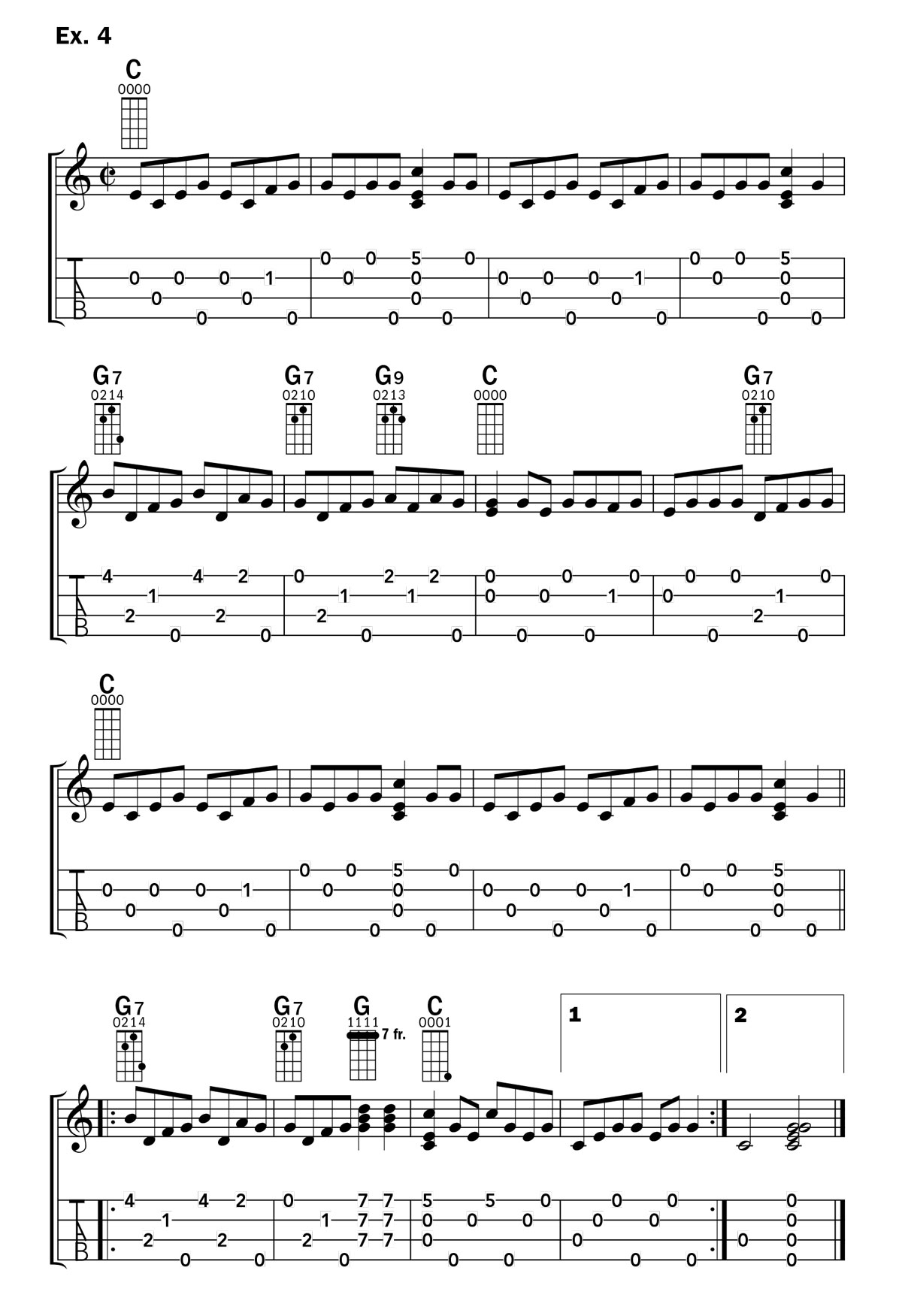
If you enjoyed working on “Manu Kapalulu,” be sure to check out Slide & Slack Key Ukulele, which has 13 more arrangements like this one, plus two dozen slide tunes in three different tunings.
And if you want to explore slack-key guitar music, listen to recordings by Gabby Pahinui, Sonny Chillingworth, Cyril Pahinui, Leonard Kwan, Atta Isaacs, and Ray Kane-just for a start.
Fred Sokolow, author of the new book Slide & Slack Key Ukulele (Hal Leonard), is a renowned performer, recording artist, and clinician. To learn more, visit sokolowmusic.com
Sunday, May 15, 2016
Thursday, May 12, 2016
FIRST LOOK: Martin 0X Uke Bamboo Soprano Ukulele
By Greg Olwell
Each year, Martin introduces a handful of limited edition models and one of this year's crop called out to us. The Martin 0X Uke Bamboo has similar appointments and construction as Martin's 0XK soprano, but features a bamboo-patterned outer layer in striking colors.
We just received our tester and its avocado green color is one fun attention grabber. [The Bamboo is also available in red and blue.] Everyone who walks by has questions and gives it a few strums. Look for a full review and video in an upcoming issue, but in the meantime here's a first look at the 0X Uke Bamboo.
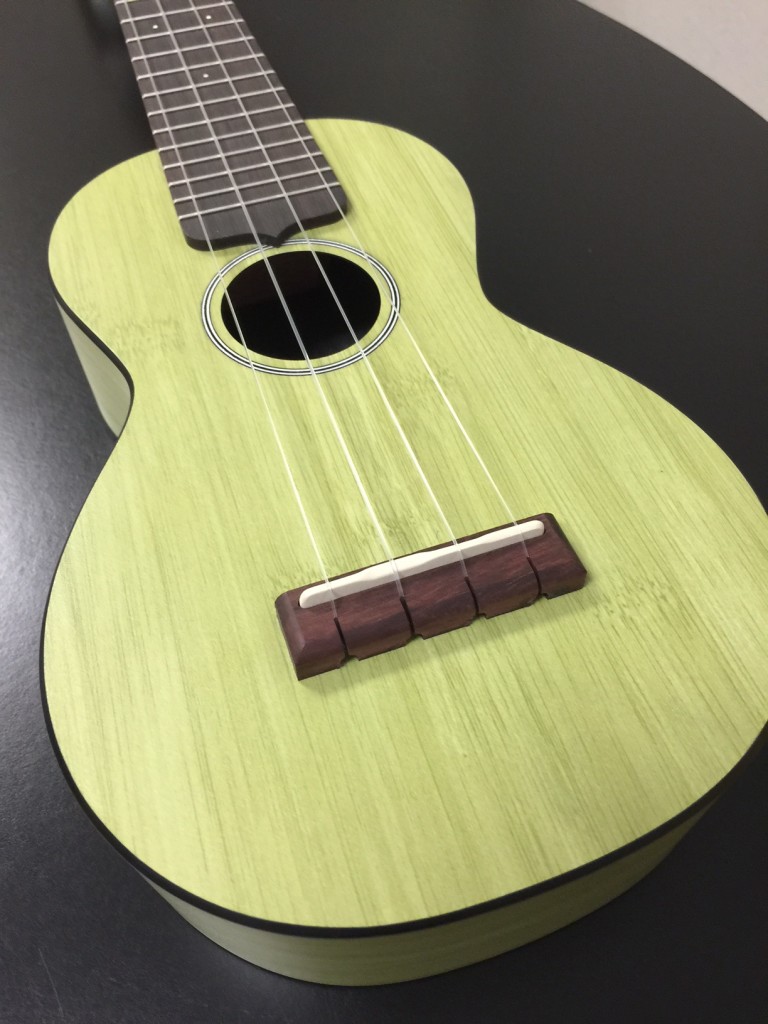
The body is made from Martin's HPL, a composite material, with Sitka spruce bracing and a bamboo-patterned finish on the top, back, sides, and headstock face.
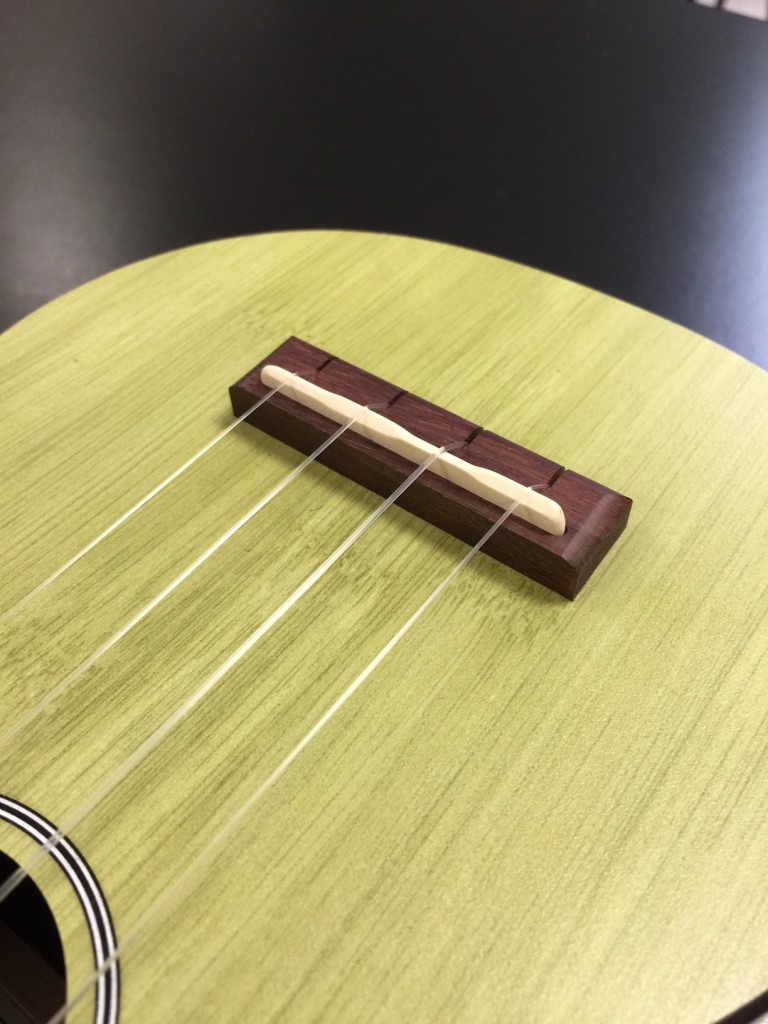
The rosewood bridge has a compensated Tusq saddle, which gave us excellent intonation along the fingerboard.
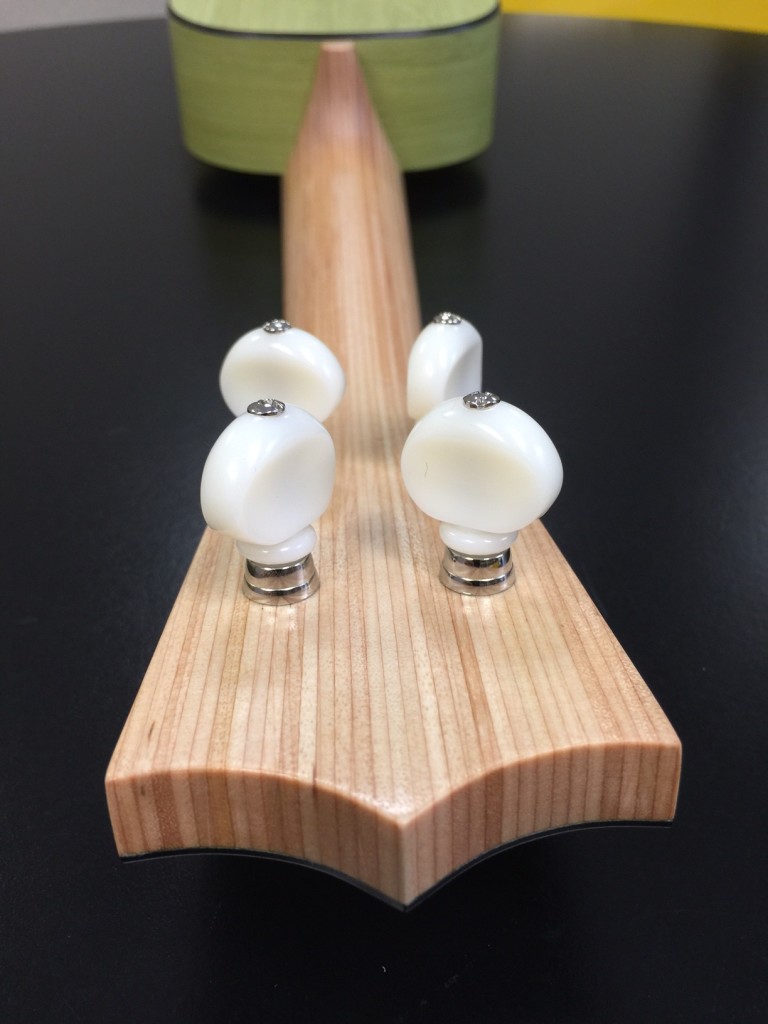
The neck is laminated birch, arranged perpendicular to the fingerboard for a striking appearance. (I counted 33 layers of birch across the headstock, the widest part of our tester's neck.)
First impressions: If any ukulele is going to make us reconsider how great a uke made from composites can feel, play, and sound, it's the 0X Bamboo. Even at $300, this uke's tone, features, and excellent construction makes a powerful argument for how great composites can be for players and instruments.
Martin's MSRP for the 0X Uke Bamboo is $449, with a street price of $299, including a soft padded gigbag. martinguitar.com
Wednesday, May 11, 2016
Uke Hunt is Nine: Review of the Year
It's Uke Hunt's ninth birthday tomorrow. According to WebMD 9 year olds, “recognize basic social norms and appropriate behavior”. So this might be your last chance to read puerile, offensive posts like these (although I wouldn't bet on it):
May 2015
– Easy alternatives to chnking.
In tabs: Celebrating Eurovision with France Gall's Poupee de Cire, Poupee de Son.
In chords: Percy Sledge's When a Man Love a Woman and, continuing the Eurovision theme, ABBA's Waterloo.
June 2015
– The best ways to use a pick on a ukulele.
– Ukulele flamethrower.
In tabs: If I Had You and David Beckingham's takes on Leo Kottke and Bent Fabric.
In chords: Elliott Smith's Waltz #2 (XO) and ukulele scremo phenomenon twenty one pilots' We Don't Believe What's on TV.
July 2015
– Best theme tune tabs.
– A video history of the Ukulele Orchestra of Great Britain.
In tabs: A whole bunch of theme tunes and I ventured into tabbing for multiple ukuleles with a UOGBesque version of Miserlou.
In chords: UOGB's take on Kate Bush's Wuthering Heights and songs from Steven Universe.
September 2015
– Happy Birthday to You finally got released from the fraudulent clutches of Warner/Chappell and I celebrated with chords and two tabs of the tune.
– I set up a new system for rating ukuleles in the ukulele review section which produced a list of the top 10 rated ukuleles. Kamaka and KoAloha have, not altogether surprisingly, been fighting it out at the top. At the time of writing Kamaka are ahead by 0.02 of a point of KoAloha and Mya-Moe in second place. If you want to have your say, find your uke in this list of ukulele makes and rate away.
– I started doing short video tabs on Instagram.
– The big ukulele chord quiz.
In tabs: An instrumental version of Tiptoe Through the Tulips and Gwent Flute Song from The Witcher 3.
In chords: I was surprised by how successful The Libertines' reformation was and did Don't Look Back into the Sun.
October 2015
– For Halloween some spooky ukulele sounds and a roundup of spine-chilling songs.
– The most iconic strumming patterns.
In tabs: After years of trying to get a version I liked, I finally finished an arrangement of Dave Brubeck's Take Five. Plus a group arrangement of the Ghostbusters theme ,a medley of songs from the Back to the Future trilogy and Schubert's Die Furelle.
In chords: Adele's stunning comeback Hello and Hall & Oates' Rich Girl.
November 2015
– The easiest ways to improve your playing.
– UkeTube Paris special.
In tabs: Penguin Cafe Orchestra's ukulele-cuatro duet Paul's Dance and the theme to 90s British sitcom Men Behaving Badly.
In chords: Eagles of Death Metal's I Want You So Hard and The Smiths' Unhappy Birthday.
December 2015
– The best (and worst) of ukuleles in 2015.
– 2015 ukulele quiz.
In tabs: Winter Wonderland and Seven rock riffs including White Stripes, Weezer and CCR.
In chords: Everything Stays from Adventure Time and The Pretenders' 2000 Miles.
February 2016
– The second edition of my book Ukulele for Dummies was released with new chapters and digital downloads.
– Ukulele festivals 2016.
In tabs: Best Bowie intros. Jonathan Lewis shared a tab of Loftus Jones from his Irish Tunes for Campanella Ukulele ebook.
In chords: Bowie's Life on Mars and Hoagy Carmichael's I Get Along Without You Very Well.
March 2016
– How to make ukulele tabs with Guitar Pro.
In tabs: Damien Rice's 9 Crimes, Sufjan Stevens's Death with Dignity and Langtree's Lament from Over the Garden Wall.
In chords: The Pogues' If I Should Fall from Grace with God and Chris Stapleton's Tennessee Whiskey.
April 2016
– Prince's favourite chord trick
– A look at ukulele capos.
– New Zealand ukulele legend Bill Sevesi passed away.
In tabs: Top five Prince riffs and the Neko Atsume theme.
In chords: Prince's How Come U Don't Call Me Anymore and The Rolling Stones' Sympathy for the Devil.
Monday, May 9, 2016
Add Ease and Elegance to Basic Ukulele Chords With Your Pinky
From the Summer 2016 Issue of Ukulele Magazine | BY JIM BELOFF
It's all about the G. Those who have taken my advanced-beginner workshops know that the biggest “aha” moment of the class comes when I talk about the G chord. I introduce it with the arrangement of “Are You Lonesome Tonight?” from my songbook Daily Ukulele, but you can practice with any song where the first chord is G. Before the students start playing, I confirm that everyone knows how to play a G chord. Most everyone does. Then I ask what fingers they use to make it. Virtually everyone uses their index, middle, and ring fingers like most of the beginner books and DVDs teach. (Ex. 1)
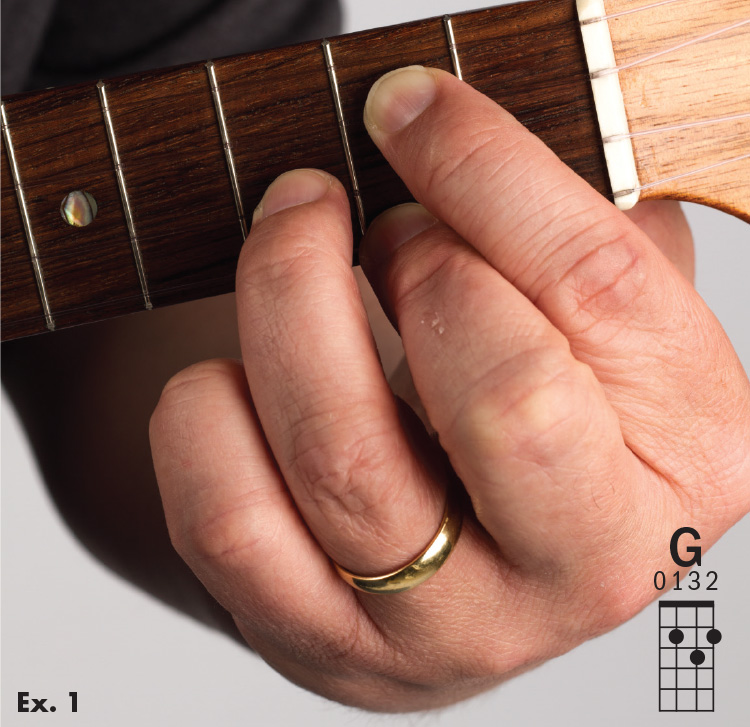
In the middle of the song, there is a simple and common chord change from G to G7. (Ex. 2) I ask the class how many fingers they can re-use from their G chord to make a G7 chord. Correct answer: none. All the fingers used to make the G have to be lifted and repositioned to make the G7.
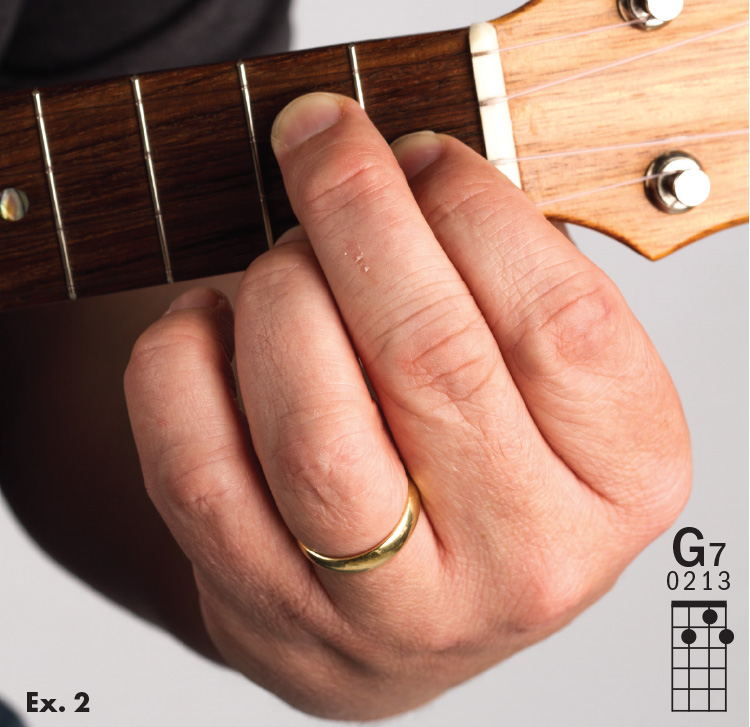
Next, I suggest that they try something that may seem awkward-make the G chord with their middle and ring fingers and their pinky. (Ex. 3) It feels odd, but I ask them to humor me. Having made a G chord this way, now how many fingers can they re-use to make a G7? Answer: two. The middle and ring fingers stay put, but simply by lifting the pinky and putting down the index finger on the first fret of the E string they have transitioned from a G to a G7. (Ex. 3 and 2) I then take it one step further, suggesting that they replace every G chord with a G7. They can even leave their index finger where it is since the pinky at the third fret cancels out the first fret.
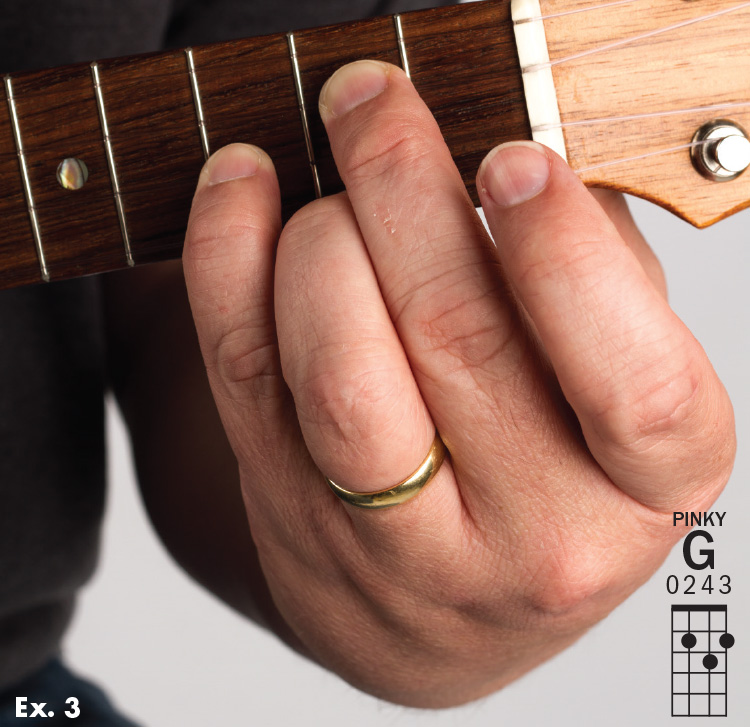
WHAT'S ALL THE FUSS
If you've never had a problem switching between G and G7, you may wonder why I'm making a fuss. The answer is something I refer to as “zen ukulele.” The point is not to change how someone plays their G chord, it's to open the player up to using his or her fingers more efficiently to allow for easier chord transitions. For example, by playing a G chord with your pinky, you can move to an E7 by dropping your index finger on the G string's first fret and lifting your pinky. (Ex. 4) A Hawaiian D7 chord (Ex. 5) made with the middle and ring fingers can easily drop (one string each) into a pinky G.
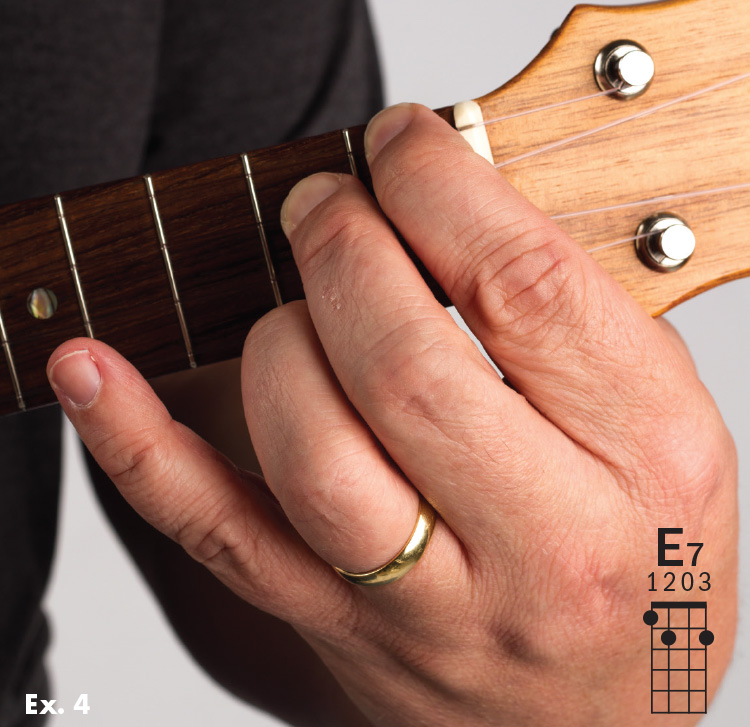
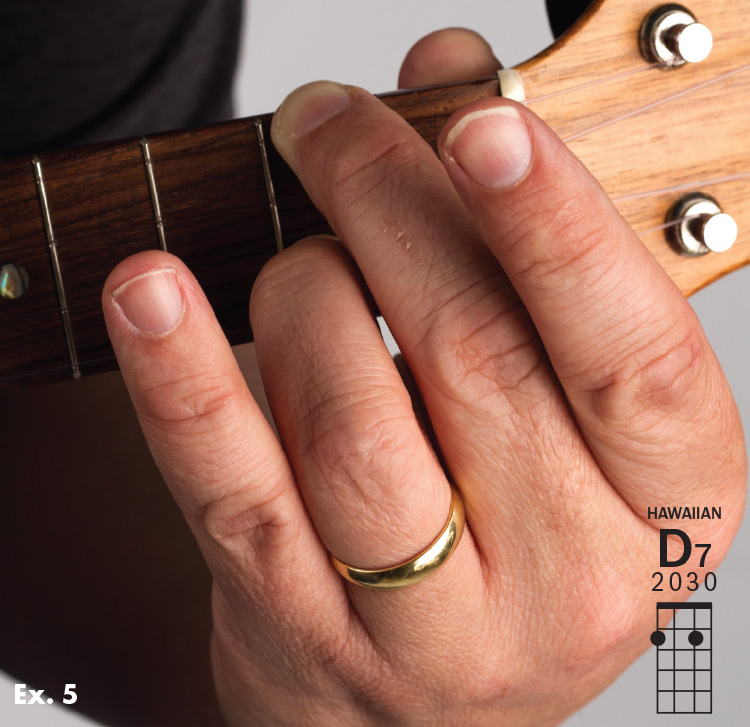
Most important, though, get used to using your pinky as soon as possible. The reason why books teach the G with index, middle, and ring fingers is because those are the strongest fingers. The pinky is the weakest finger and in the beginning it's only natural to try to avoid using it. On the other hand, many of the sophisticated, jazzy chords that many players love require four fingers. My advice is to get your pinky in the game as soon as possible so it can carry its weight with those richer, more interesting four-fingered chords.
It's no overstatement to say that the Pinky G can be a revelation for advanced beginners. It opens them up to the idea that the fingers used to make certain chords are not fixed and should take into account the chords that come before and after. To me, the secret to a long and satisfying relationship with the ukulele is the ability to play any song with any number of chords. Moving gracefully and efficiently from one chord to the next is critical to achieving that goal.
A personal anecdote: When I was just starting out on ukulele, there was a moment when I looked down at my chording hand and noticed I was playing a C chord with my pinky. (Ex. 6) Knowing that many of us learn to play a C chord with our ring fingers, I was fascinated to think that my hand had over-ruled my head and decided to make a C with my pinky. Then it dawned on me: It was like my hand had already determined that using my pinky to make a C chord was more efficient, since I could more easily transition from it to a three-fingered chord.
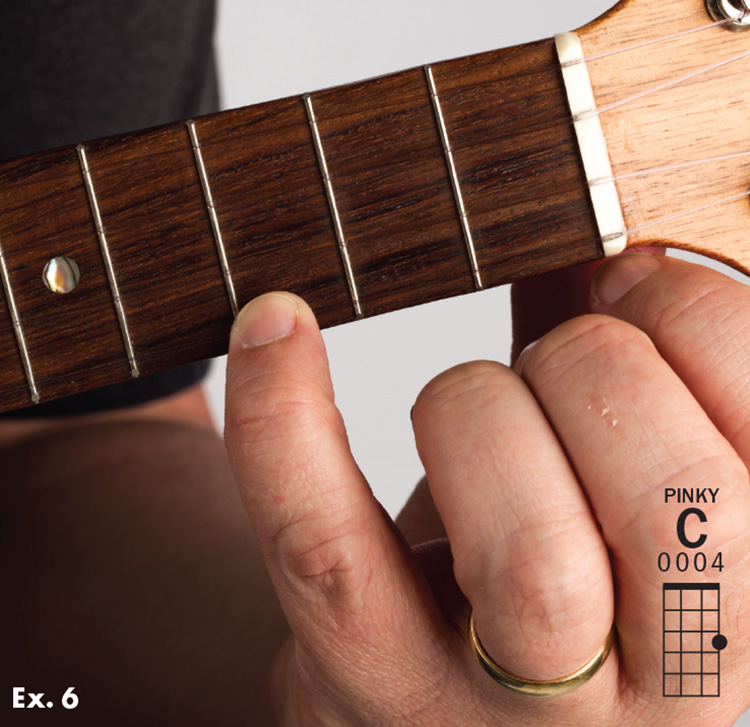
So, humor me.
Give the Pinky G and Pinky C a try. Who knows, it might open you up to all sorts of new possibilities.
Jim Beloff is the author of The Ukulele-A Visual History and arranger and publisher of the Jumpin' Jim series of ukulele songbooks, including the best-selling Daily Ukulele. Learn more at fleamarketmusic.com.

This article originally appeared in the Summer 2016 issue of Ukulele magazine.
Subscribe to:
Posts (Atom)
